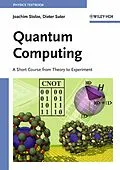Endlich ein Lehrbuch zum Thema Quanten-Computing, das auch die experimentelle Umsetzung ausführlich diskutiert! Didaktisch geschickt haben die Autoren, erfahrene Lehrkräfte, die Grundlagen der Quantenkommunikation und der Quanten-Informationsverarbeitung aufgearbeitet. Sie führen den Leser weiter zu modernen technischen Implementationen. Fehlerquellen und Dekohärenzphänomene werden ebenso besprochen wie Methoden zu ihrer Vermeidung und Korrektur.
Autorentext
Prof. D. Suter is an experimentalist and well known for his NMR-work and currently working on quantum computation projects. He worked with Nobel laureate Ernst RR in Zurich.
Also Prof. J. Stolze is known to be a good teacher. As a theorist, his topic research area is quantum spin chains.
Klappentext
First textbook on the topic which discusses theoretical foundations as well as experimental realizations in detail. The authors, both experienced teachers, didactically prepare the basics of quantum communication and quantum information processing, leading readers to modern technical implementations. They also discuss errors and decoherence as well as methods of avoiding and correcting them.
Zusammenfassung
The result of a lecture series, this textbook is oriented towards students and newcomers to the field and discusses theoretical foundations as well as experimental realizations in detail. The authors are experienced teachers and have tailored this book to the needs of students. They present the basics of quantum communication and quantum information processing, leading readers to modern technical implementations. In addition, they discuss errors and decoherence as well as methods of avoiding and correcting them.
Inhalt
Preface.
1 Introduction and survey.
1.1 Information, computers and quantum mechanics.
1.1.1 Digital information.
1.1.2 Moore's law.
1.1.3 Emergence of quantum behavior.
1.1.4 Energy dissipation in computers.
1.2 Quantum computer basics.
1.2.1 Quantum information.
1.2.2 Quantum communication.
1.2.3 Basics of quantum information processing.
1.2.4 Decoherence.
1.2.5 Implementation.
1.3 History of quantum information processing.
1.3.1 Initial ideas.
1.3.2 Quantum algorithms.
1.3.3 Implementations.
2 Physics of computation.
2.1 Physical laws and information processing.
2.1.1 Hardware representation.
2.1.2 Quantum vs. classical information processing.
2.2 Limitations on computer performance.
2.2.1 Switching energy.
2.2.2 Entropy generation and Maxwell's demon.
2.2.3 Reversible logic.
2.2.4 Reversible gates for universal computers.
2.2.5 Processing speed.
2.2.6 Storage density.
2.3 The ultimate laptop.
2.3.1 Processing speed.
2.3.2 Maximum storage density.
3 Elements of classical computer science.
3.1 Bits of history.
3.2 Boolean algebra and logic gates.
3.2.1 Bits and gates.
3.2.2 2-bit logic gates.
3.2.3 Minimum set of irreversible gates.
3.2.4 Minimum set of reversible gates.
3.2.5 The CNOT gate.
3.2.6 The Toffoli gate.
3.2.7 The Fredkin gate.
3.3 Universal computers.
3.3.1 The Turing machine.
3.3.2 The ChurchTuring hypothesis.
3.4 Complexity and algorithms.
3.4.1 Complexity classes.
3.4.2 Hard and impossible problems.
4 Quantum mechanics.
4.1 General structure.
4.1.1 Spectral lines and stationary states.
4.1.2 Vectors in Hilbert space.
4.1.3 Operators in Hilbert space.
4.1.4 Dynamics and the Hamiltonian operator.
4.1.5 Measurements.
4.2 Quantum states.
4.2.1 The two-dimensional Hilbert space: qubits, spins, and photons.
4.2.2 Hamiltonian and evolution.
4.2.3 Two or more qubits.
4.2.4 Density operator.
4.2.5 Entanglement and mixing.
4.2.6 Quantification of entanglement.
4.2.7 Bloch sphere.
4.2.8 EPR correlations.
4.2.9 Bell's theorem.
4.2.10 Violation of Bell's inequality.
4.2.11 The no-cloning theorem.
4.3 Measurement revisited.
4.3.1 Quantum mechanical projection postulate.
4.3.2 The Copenhagen interpretation.
4.3.3 Von Neumann's model.
5 Quantum bits and quantum gates.
5.1 Single-qubit gates.
5.1.1 Introduction.
5.1.2 Rotations around coordinate axes.
5.1.3 General rotations.
5.1.4 Composite rotations.
5.2 Two-qubit gates.
5.2.1 Controlled gates.
5.2.2 Composite gates.
5.3 Universal sets of gates.
5.3.1 Choice of set.
5.3.2 Unitary operations.
5.3.3 Two qubit operations.
5.3.4 Approximating single-qubit gates.
6 Feynman's contribution.
6.1 Simulating physics with computers.
6.1.1 Discrete system representations.
6.1.2 Probabilistic simulations.
6.2 Quantum mechanical computers.
6.2.1 Simple gates.
6.2.2 Adder circuits.
6.2.3 Qubit raising and lowering operators.
6.2.4 Adder Hamiltonian.
7 Errors and decoherence.
7.1 Motivation.
7.1.1 Sources of error.
7.1.2 A counterstrategy.
7.2 Decoherence.
7.2.1 Phenomenology.
7.2.2 Semiclassical descr...
